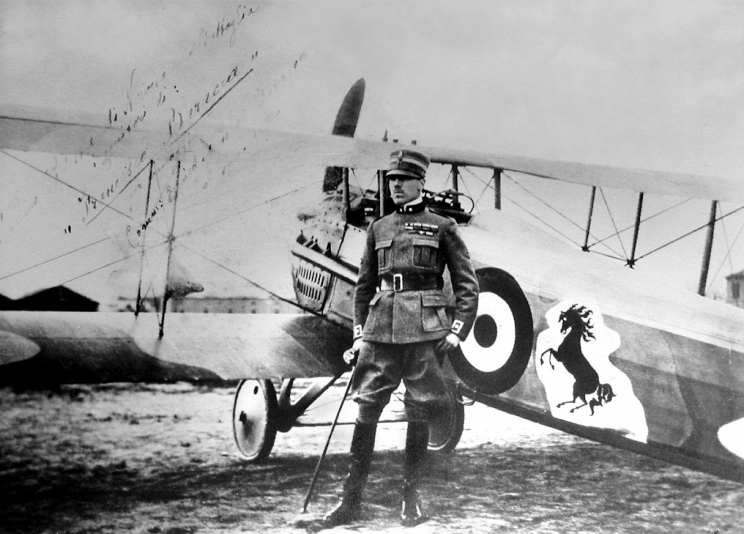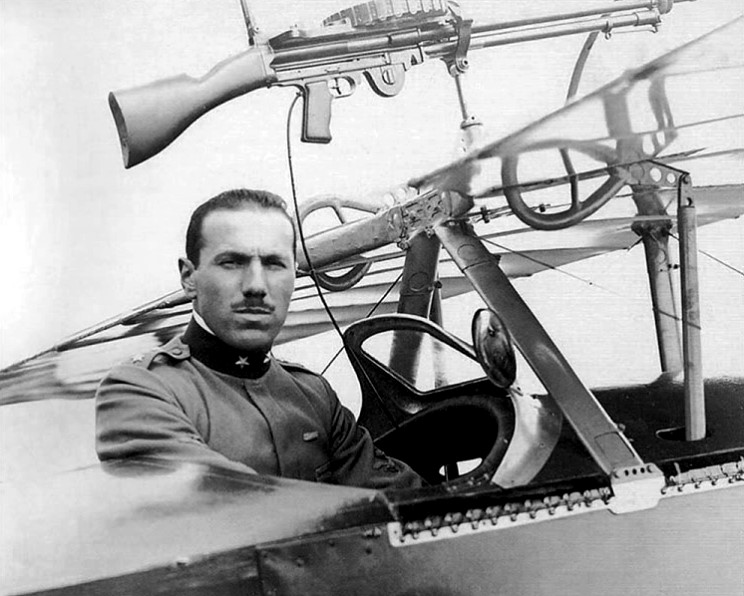Maggiore Count
Francesco Baracca |
|
(1888-1918) |
 |
Count Francesco Baracca seen by his Spad XIII during the Great War. |
 |
Count Francesco Baracca, probably in a Nieuport fighter during World War 1. |
Francesco Baracca (May 9, 1888 - June 19, 1918) was Italy's top fighter ace of World War I. Baracca was born in Lugo di Romagna. He initially studied at the 'Dante' lyceum in Florence before, in October 1907, he entered the Modena military academy and became a cavalryman with the 2nd Piemonte Reale Regiment upon commissioning. Baracca became interested in aviation and learned to fly at Rheims, France, receiving his pilot's license in July 1912. He then served with the Battaglione Aviatori and in 1914 with the 5th and 6th Squadriglias. Italy declared war on Austria on 19 May 1915. After Italy's entry into the war on the Allied side, Baracca flew operationally during 1915. In May 1915 he was sent to Paris to convert to Nieuport two-seaters and then served with the 1st Squadriglia. The Nieuport 11 single seat fighter entered service in April 1916, and on 7 April, flying this new fighter he scored his first victory, an Austrian Hansa-Brandenberg, wounding its two-man crew. This was also the first for Italy in the war. Baracca's second victory was an Austrian Lohner over Gorizia on 23 April 1916. Promoted to Capitano, Baracca remained with the unit until, with 8 victories, he transferred as Commander of the newly formed 91st Squadriglias in 1 May 1917. The 91a Squadriglia, known as the "Squadron of the Aces", included fellow aces Prince Fulco Ruffo di Calabria and Count Pier Ruggiero Piccio. Count Baracca at this time adopted as a personal emblem a black prancing horse, in tribute to his former cavalry regiment. This prompted some to call him, "The Cavalier of the Skies". Flying the Nieuport 17 and then, from March 1917, the SPAD VII he raised his score to 30 at the end of 1917. A dedicated fighter pilot, Baracca found life away from the front unbearable and remained as much as possible with the 91st Squadriglia, even after being promoted maggiore in November 1917. Baracca remained a modest, sensitive man conscious of his duty and compassionate to both his squadron comrades and to his defeated enemies. Baracca saw little action in 1918, but he added more victories, for a total of 34, before failing to return from a strafing mission on the Montello on 19 June. His body, found a few days later, reportedly bore the marks of a bullet to the head. In his hand, he held a pistol, leading to suspicions that he elected to take his own life rather than die in a crash or be taken prisoner. An Austrian pilot reportedly claimed to have shot him down in combat. Both these theories are unsupported by firm evidence and the most accepted version is that Baracca, who was flying a low-altitude strafing mission, was hit by ground-fire. Baracca's total of 34 victory claims can largely be verified from known Austro-Hungarian losses and surviving military records, establishing the Italian as one of the highest scoring Allied pilots during the conflict. Many roads in Italy are named after him. The airport of Bolzano, a city in the Alto Adige region previously belonging to the Austro-Hungarian Empire, the Roma-Centocelle Italian Air Force base, and the Lugo di Romagna air field are all named after Baracca. In later years, Baracca's father presented Baracca's prancing stallion emblem, the Cavallino Rampante to Enzo Ferrari. The rearing horse has been the official symbol of Scuderia Ferrari racing team since 1929, and of Ferrari automobiles since they began manufacture. |
(Text courtesy of Wikipedia) |
Page published Sept. 9, 2009 |